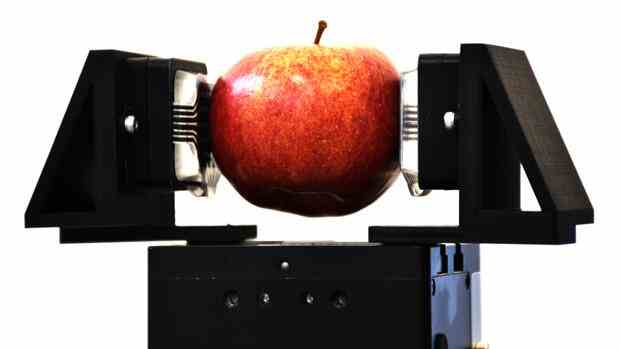Munich In science fiction films, robots are almost indistinguishable from humans. The reality is still different, even after decades of research and development: So far, industry has hardly succeeded in simulating, for example, the human hand with its sensitive skin and special mechanical abilities.
Many activities, from apple harvesting to handling test tubes and handling rubber shoe soles, are therefore difficult for robots to take on. “Anyone who can do that opens up a market that is almost infinitely large,” says Poweron co-founder Markus Henke.
The first product, the sensitive fingertip Touchdetect, has now been developed for pilot projects in which the capabilities and possible uses are tested. “The fingertip can easily be integrated into existing, commercially available gripper systems,” says Henke. The fingertip is made of silicone. A thin film with sensors printed on it is stretched over it.
Top jobs of the day
Find the best jobs now and
be notified by email.
So far, the devices have tended to be geared towards gross motor skills. For example, they had to be programmed exactly how far they reach. That should change now.
For Poweron, the sensitive fingertip is just the beginning. “We want to dissolve the barriers between people and machines,” says Henke. The company is also working on plastics that deform when an electric current is passed. Muscles can be imitated in this way. “We can create structures that have reflexes,” says Henke.
The engineer founded Poweron with a team from the University of Auckland in New Zealand.
(Photo: Poweron)
Controlled by artificial neurons, such muscles can then drive grippers. In a demonstrator, the start-up, which is in the very early phase, has now shown this interaction in reality for the first time.
You could get a lot closer to the visions of the future from films. In about 15 years, humanoid robots are conceivable that no longer consist only of metals, but of bio-inspired materials like those that Poweron is working on, says Henke. But the question is whether this is also wanted: “If a robot is too human-like, it triggers fears in some people.”
The cobot segment is still comparatively small
So the robot will probably remain recognizable as such for a long time to come. With the technologies that Poweron and others are working on, the areas of application could be significantly expanded – and give the collaborating robots another significant boost.
Because last year, according to the world industry association IFR, the number of deliveries increased by 50 percent to 39,000 installed “cobots”, as collaborative robots are called in the industry. But by no means all the hopes placed in robots that work together with humans in the factory hall have been fulfilled.
In smaller companies in particular, most activities are still carried out manually. The traditional, heavy industrial robots continue to dominate sales, of which 478,000 were sold last year.
The Dresden-based company is active in so-called bio-inspired robotics.
(Photo: Poweron)
Esben Östergaard, who once founded the cobot world market leader Universal Robots, is convinced that this will soon change: “The cobot segment will definitely become larger than that of the classic heavy industrial robots,” he told the Handelsblatt.
But to do this, the cobots must be able to take on significantly more of the tasks that were previously done by hand. This is currently often not possible with fragile objects or flexible materials such as rubber. The more sensitive robots could also be used in the semiconductor industry, medical technology or, for example, when handling eggs in vaccine production.
Many companies and research institutions around the world are currently working on this topic. Johannes Weichart, a doctoral student in the Micro and Nano Systems group at ETH Zurich, has developed an artificial skin that is intended to enable robots to touch and feel. It is equipped with about one sensor per square millimeter. These sensors contain balls that compress the electrical conductors. In this way, the pressure and the direction can be determined.
“It’s time for new materials and new products”
The next step is to make the skin more robust. “So that we can use the artificial skin in everyday life, we have to provide the sensors with a protective layer,” says Weichart. In addition, the complexity must be significantly reduced so that the amount of raw data can still be processed.
An interesting approach, says Henke. However, this solution relies on classic materials such as metals and micromechanical manufacturing processes. The sensor is also not stretchable, since the metal conductors would not be able to cope with it. Science often tries to solve future problems with established technologies. “We think it’s time for new materials and new products,” he says.
The engineer founded the start-up in 2019 together with a team from the University of Auckland in New Zealand. The company now also has a seat in Dresden. Poweron is currently organizing the next round of financing, with the help of which pilot projects are to be implemented and the first products launched on the market.
More: The shortage of skilled workers arouses interest in robots in medium-sized companies
